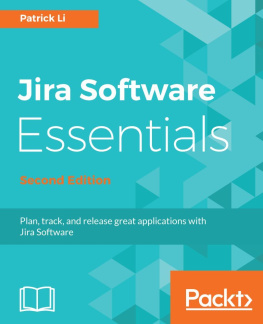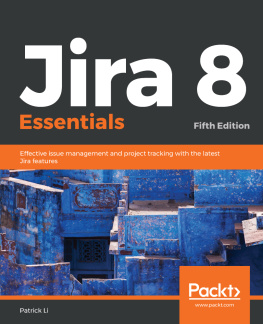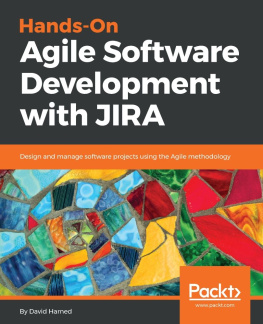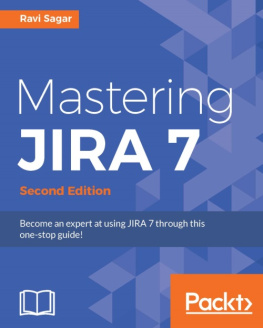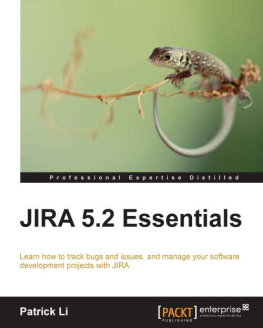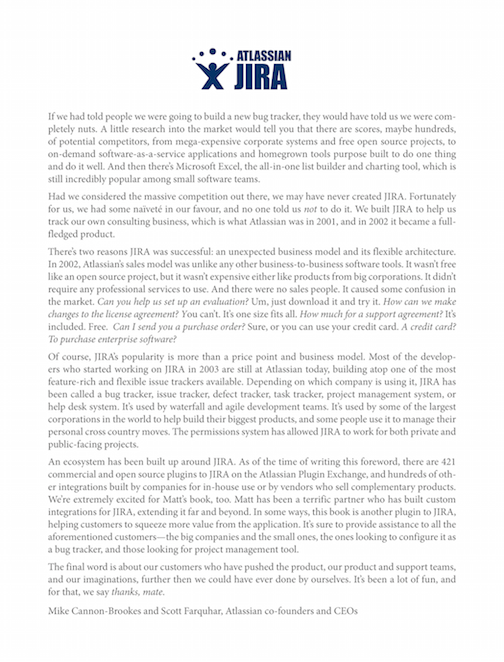What This Book Is About
This book is about JIRA, the popular issue tracker from Atlassian. An issue tracker lets people collaborate more effectively when there are things to be done. It also replaces copies of spreadsheets in email. You can use an issue tracker for everything from tracking bugs in software to customer support requests, and beyond . I like to say that JIRA is a big To Do list for teams.
The book is intended for readers who administer a JIRA instance or design how JIRA is used locally. It assumes a basic familiarity with what JIRA can do and provides more information about how JIRA is intended to be used.
Each chapter should help clarify some confusing aspect of JIRA administration. The chapters are only loosely connected to each other, with the intention that they can be read in any order. Most new administrators start with the chapters about schemes and workflows. covers upgrades, migrations and then finally some common frustrations with JIRA.
The intention of this book is to supplement but not repeat the extensive JIRA documentation, freely available at http://confluence.atlassian.com/display/JIRA/JIRA+Documentation.
In selecting the different topics to cover in this book, I was conscious of the different questions that I, as a software toolsmith, am asked about JIRA every day. I chose the most frequently asked and difficult ones. If you cant find a particular topic and think it should be in a book such as this, then please do contact me with more details.
Some of the topics that are covered are expanded versions of entries already posted to my old blog Practical JIRA Development, at .
JIRA Versions and System Details
The fourth release and current refers to version 7.0 which was released in October 2015. Where there are differences between versions of JIRA and the Atlassian-hosted JIRA Cloud service, these are noted in the text.
The first release of this book referred to JIRA version 4.2.4 Standalone, which was released in February 2011.
The second release referred to version 5.0, which was released in February 2012.
The third release referred to version 6.0, which was released in May 2013.
The target system used throughout this book is a Linux server with JDK 1.8 and MySQL. The main differences for other operating systems, deployment types, databases, and JVMs are the installation instructions and the names and paths of certain files. These details are described in the online JIRA documentation.
There are two main choices for deploying JIRA:
JIRA ServerThis is the original JIRA deployment package, also known as Standalone and Behind the Firewall (BTF). WAR packages for JIRA Server are no longer provided by Atlassian since JIRA 7.0.
JIRA CloudFormerly known as Studio and OnDemand, this is the cloud version of JIRA. Some features of JIRA Server are not available in JIRA Cloud.
Development Environment
This book was written using OSX 10.10.4 on a MacBook Pro (Retina, mid-2014), using DocBook 4.5, Emacs 22.1.50.1 and git 1.7.5.4. The output files were generated using a custom web-based authoring tool named Atlas, developed by OReilly for their authors. Using a web-based tool allows books to be updated more frequently and the different output formats generated automatically.
Coauthor
The fourth update of this book for JIRA 7.0 includes a new chapter by my ServiceRocket colleague Mikey Schott ().
Mikey SchottMikey has worked as a corrosion survey technician, a satellite janitor, and a record store employee, but seems to have found most success consulting and training people on JIRA. His non-paying gigs include community theater acting and crossword puzzle solver. He is also a member of the Atlassian Certification Advisory Board.
Technical Reviewers
Stafford VaughanStafford started using JIRA in 2005 after completing a Software Engineering degree in Australia and joining CustomWare, Atlassians leading services partner. He is a founding author of Atlassians official JIRA training course materials, and has spent the past five years delivering training to hundreds of organizations worldwide. Stafford currently lives in San Francisco and works in Silicon Valley at Apple.
Bryan RollinsBryan is the General Manager for Atlassian JIRA.
Paul SladePaul is a member of the Atlassian JIRA development team.
Matt QuailMatt is a member of the Atlassian JIRA development team.
Matt SilverMatt Silver has worked in the technical support field for 10 years and now works for Twitter. Hes an avid rock drummer and lives in Northern California.
Roger SymondsRoger has built and run Atlassian training courses delivered globally to over 20,000 attendees, and personally delivered training at a hat-trick of Atlassian Summits. Hes a Sydneysider who enjoys flying gliders and playing guitar.
Conventions Used in This Book
The following typographical conventions are used in this book:
Italic
Indicates new terms, URLs, email addresses, filenames, and file extensions.
Constant widthUsed for program listings, as well as within paragraphs to refer to program elements such as variable or function names, databases, data types, environment variables, statements, and keywords.



